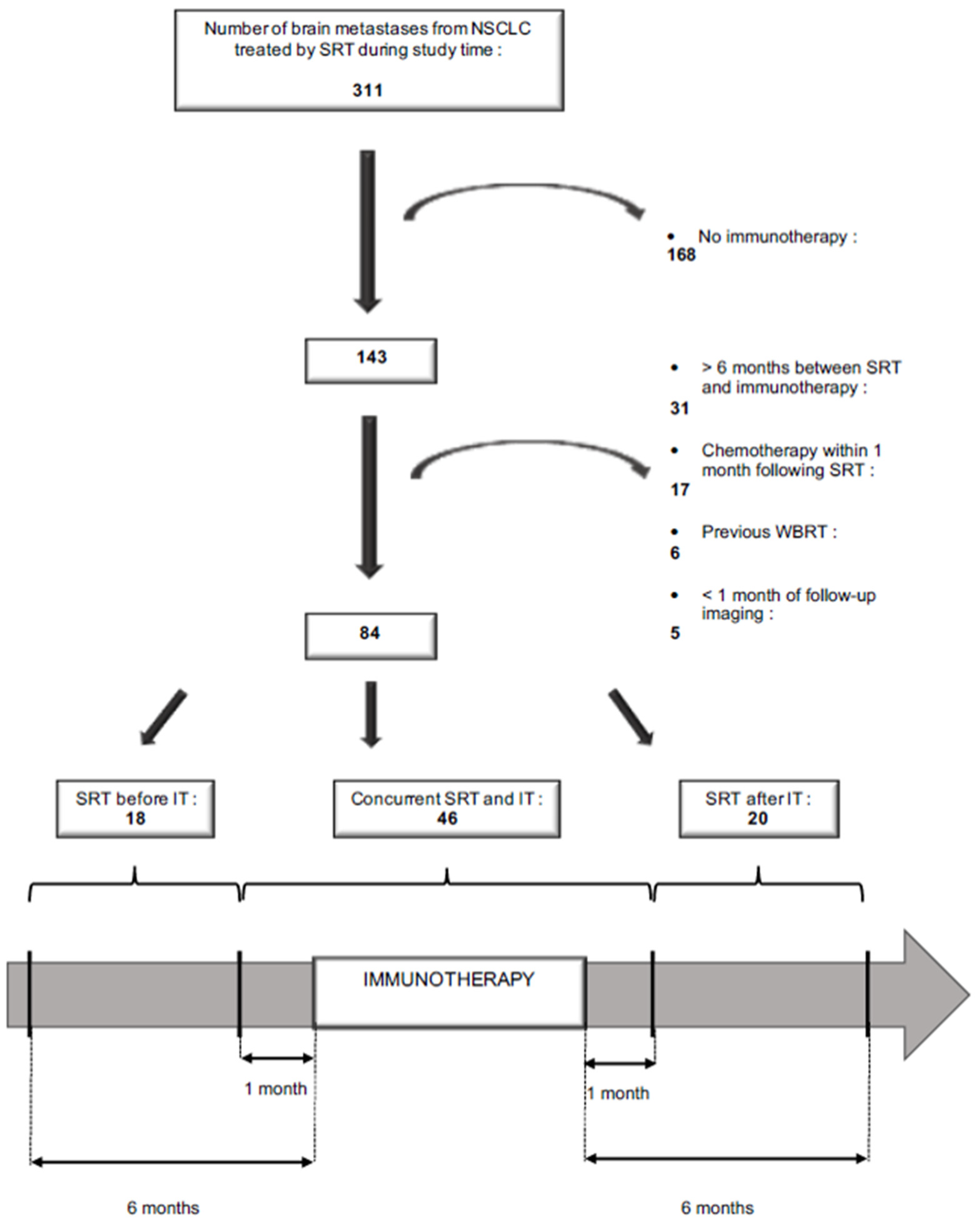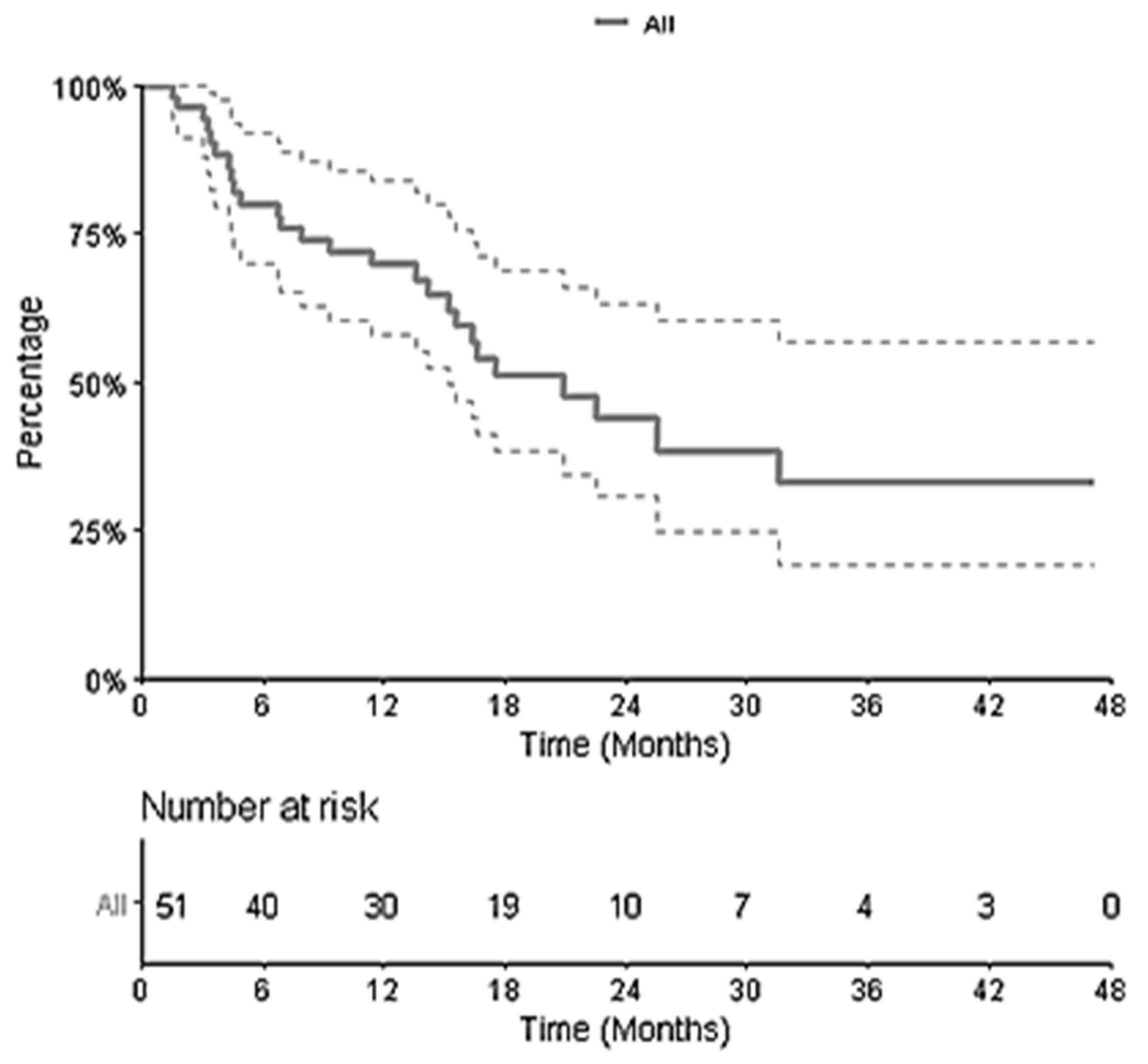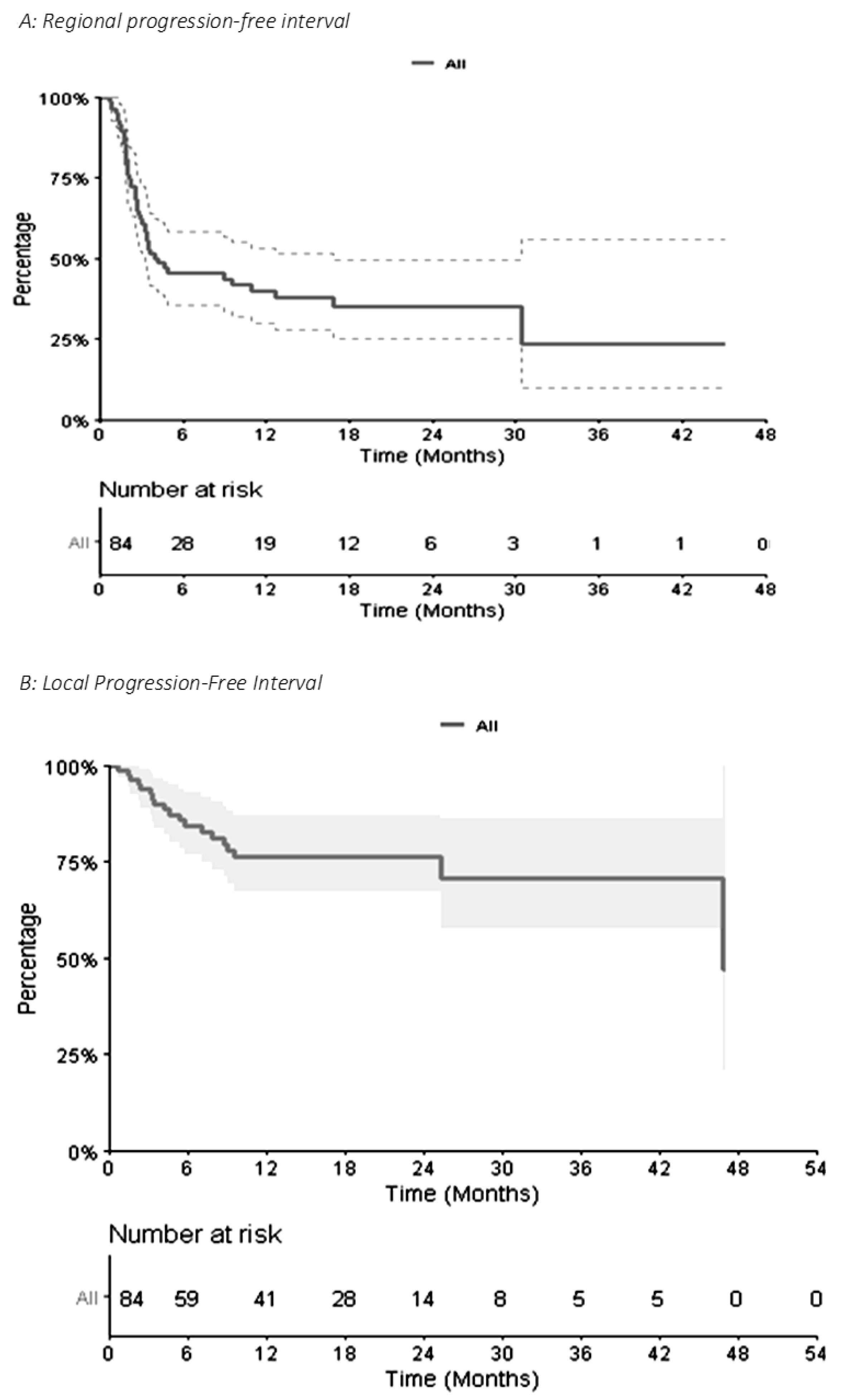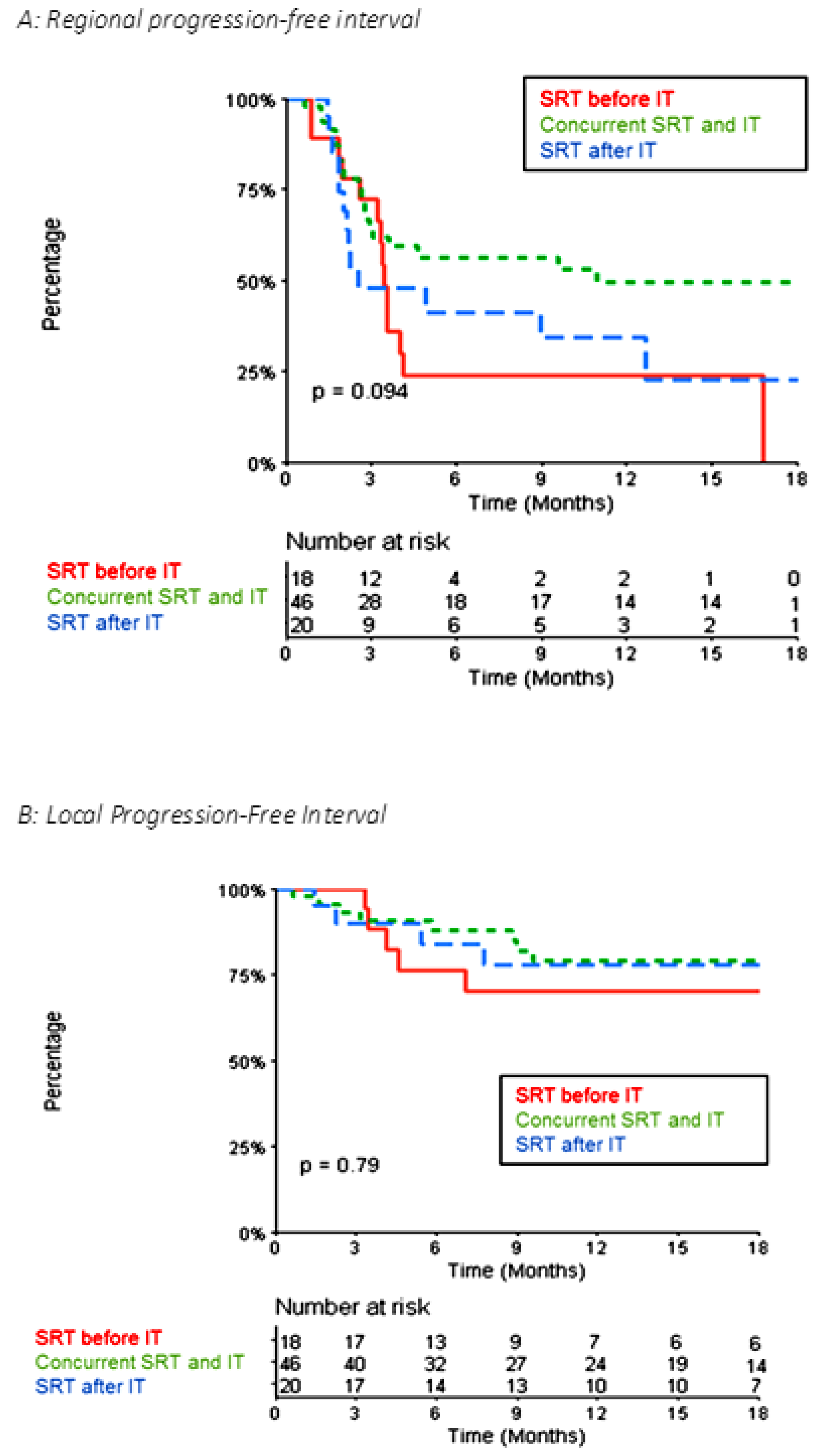Efficacy and Safety of Combined Brain Stereotactic Radiotherapy and Immune Checkpoint Inhibitors in Non-Small-Cell Lung Cancer with Brain Metastases
Abstract
:1. Introduction
2. Materials and Methods
2.1. Patient Selection
2.2. Radiation Therapy
2.3. Immunotherapy
2.4. Follow-Up
2.5. Statistical Analysis
3. Results
3.1. Patients’ Characteristics
3.2. Locoregional Control and Overall Survival
3.3. Toxicity
3.3.1. Acute Neurologic Toxicity
3.3.2. Brain Radionecrosis
4. Discussion
Supplementary Materials
Author Contributions
Funding
Institutional Review Board Statement
Informed Consent Statement
Data Availability Statement
Conflicts of Interest
References
- Nussbaum, E.S.; Djalilian, H.R.; Cho, K.H.; Hall, W.A. Brain Metastases. Histology, Multiplicity, Surgery, and Survival. Cancer 1996, 78, 1781–1788. [Google Scholar] [CrossRef]
- Soffietti, R.; Kocher, M.; Abacioglu, U.M.; Villa, S.; Fauchon, F.; Baumert, B.G.; Fariselli, L.; Tzuk-Shina, T.; Kortmann, R.-D.; Carrie, C.; et al. A European Organisation for Research and Treatment of Cancer Phase III Trial of Adjuvant Whole-Brain Radiotherapy versus Observation in Patients with One to Three Brain Metastases from Solid Tumors after Surgical Resection or Radiosurgery: Quality-of-Life Results. J. Clin. Oncol. 2013, 31, 65–72. [Google Scholar] [CrossRef] [PubMed]
- Aoyama, H.; Tago, M.; Kato, N.; Toyoda, T.; Kenjyo, M.; Hirota, S.; Shioura, H.; Inomata, T.; Kunieda, E.; Hayakawa, K.; et al. Neurocognitive Function of Patients with Brain Metastasis Who Received Either Whole Brain Radiotherapy plus Stereotactic Radiosurgery or Radiosurgery Alone. Int. J. Radiat. Oncol. Biol. Phys. 2007, 68, 1388–1395. [Google Scholar] [CrossRef] [PubMed]
- Chang, E.L.; Wefel, J.S.; Hess, K.R.; Allen, P.K.; Lang, F.F.; Kornguth, D.G.; Arbuckle, R.B.; Swint, J.M.; Shiu, A.S.; Maor, M.H.; et al. Neurocognition in Patients with Brain Metastases Treated with Radiosurgery or Radiosurgery plus Whole-Brain Irradiation: A Randomised Controlled Trial. Lancet Oncol. 2009, 10, 1037–1044. [Google Scholar] [CrossRef]
- Brown, P.D.; Jaeckle, K.; Ballman, K.V.; Farace, E.; Cerhan, J.H.; Anderson, S.K.; Carrero, X.W.; Barker, F.G.; Deming, R.; Burri, S.H.; et al. Effect of Radiosurgery Alone vs Radiosurgery with Whole Brain Radiation Therapy on Cognitive Function in Patients with 1 to 3 Brain Metastases: A Randomized Clinical Trial. JAMA 2016, 316, 401–409. [Google Scholar] [CrossRef]
- Sperduto, P.W.; Shanley, R.; Luo, X.; Andrews, D.; Werner-Wasik, M.; Valicenti, R.; Bahary, J.-P.; Souhami, L.; Won, M.; Mehta, M. Secondary Analysis of RTOG 9508, a Phase 3 Randomized Trial of Whole-Brain Radiation Therapy versus WBRT plus Stereotactic Radiosurgery in Patients with 1-3 Brain Metastases; Poststratified by the Graded Prognostic Assessment (GPA). Int. J. Radiat. Oncol. Biol. Phys. 2014, 90, 526–531. [Google Scholar] [CrossRef]
- Alongi, F.; Fiorentino, A.; Navarria, P.; Bello, L.; Scorsetti, M. Stereotactic Radiosurgery for Patients with Brain Metastases. Lancet Oncol 2014, 15, e246–e247. [Google Scholar] [CrossRef]
- Yamamoto, M.; Serizawa, T.; Shuto, T.; Akabane, A.; Higuchi, Y.; Kawagishi, J.; Yamanaka, K.; Sato, Y.; Jokura, H.; Yomo, S.; et al. Stereotactic Radiosurgery for Patients with Multiple Brain Metastases (JLGK0901): A Multi-Institutional Prospective Observational Study. Lancet Oncol. 2014, 15, 387–395. [Google Scholar] [CrossRef]
- Reck, M.; Rodríguez-Abreu, D.; Robinson, A.G.; Hui, R.; Csőszi, T.; Fülöp, A.; Gottfried, M.; Peled, N.; Tafreshi, A.; Cuffe, S.; et al. Pembrolizumab versus Chemotherapy for PD-L1-Positive Non-Small-Cell Lung Cancer. N. Engl. J. Med. 2016, 375, 1823–1833. [Google Scholar] [CrossRef]
- Brahmer, J.; Reckamp, K.L.; Baas, P.; Crinò, L.; Eberhardt, W.E.E.; Poddubskaya, E.; Antonia, S.; Pluzanski, A.; Vokes, E.E.; Holgado, E.; et al. Nivolumab versus Docetaxel in Advanced Squamous-Cell Non-Small-Cell Lung Cancer. N. Engl. J. Med. 2015, 373, 123–135. [Google Scholar] [CrossRef] [Green Version]
- Gandhi, L.; Rodríguez-Abreu, D.; Gadgeel, S.; Esteban, E.; Felip, E.; De Angelis, F.; Domine, M.; Clingan, P.; Hochmair, M.J.; Powell, S.F.; et al. Pembrolizumab plus Chemotherapy in Metastatic Non-Small-Cell Lung Cancer. N. Engl. J. Med. 2018, 378, 2078–2092. [Google Scholar] [CrossRef] [PubMed]
- Borghaei, H.; Paz-Ares, L.; Horn, L.; Spigel, D.R.; Steins, M.; Ready, N.E.; Chow, L.Q.; Vokes, E.E.; Felip, E.; Holgado, E.; et al. Nivolumab versus Docetaxel in Advanced Nonsquamous Non-Small-Cell Lung Cancer. N. Engl. J. Med. 2015, 373, 1627–1639. [Google Scholar] [CrossRef] [PubMed]
- Demaria, S.; Golden, E.B.; Formenti, S.C. Role of Local Radiation Therapy in Cancer Immunotherapy. JAMA Oncol. 2015, 1, 1325–1332. [Google Scholar] [CrossRef] [PubMed]
- Melosky, B. Rapidly Changing Treatment Algorithms for Metastatic Nonsquamous Non-Small-Cell Lung Cancer. Curr. Oncol. 2018, 25, S68–S76. [Google Scholar] [CrossRef] [PubMed]
- Goldberg, S.B.; Schalper, K.A.; Gettinger, S.N.; Mahajan, A.; Herbst, R.S.; Chiang, A.C.; Lilenbaum, R.; Wilson, F.H.; Omay, S.B.; Yu, J.B.; et al. Pembrolizumab for Management of Patients with NSCLC and Brain Metastases: Long-Term Results and Biomarker Analysis from a Non-Randomised, Open-Label, Phase 2 Trial. Lancet Oncol. 2020, 21, 655–663. [Google Scholar] [CrossRef]
- Yang, Y.; Deng, L.; Yang, Y.; Zhang, T.; Wu, Y.; Wang, L.; Bi, N. Efficacy and Safety of Combined Brain Radiotherapy and Immunotherapy in Non-Small-Cell Lung Cancer with Brain Metastases: A Systematic Review and Meta-Analysis. Clin. Lung Cancer 2022, 23, 95–107. [Google Scholar] [CrossRef] [PubMed]
- Lee, M.H.; Cho, K.-R.; Choi, J.W.; Kong, D.-S.; Seol, H.J.; Nam, D.-H.; Jung, H.A.; Sun, J.-M.; Lee, S.-H.; Ahn, J.S.; et al. Immune Checkpoint Inhibitors for Non-Small-Cell Lung Cancer with Brain Metastasis: The Role of Gamma Knife Radiosurgery. J. Korean Neurosurg. Soc. 2021, 64, 271–281. [Google Scholar] [CrossRef]
- Guénolé, M.; Lucia, F.; Bourbonne, V.; Dissaux, G.; Reygagne, E.; Goasduff, G.; Pradier, O.; Schick, U. Impact of Concomitant Systemic Treatments on Toxicity and Intracerebral Response after Stereotactic Radiotherapy for Brain Metastases. BMC Cancer 2020, 20, 991. [Google Scholar] [CrossRef]
- Feuvret, L.; Noël, G.; Mazeron, J.-J.; Bey, P. Conformity Index: A Review. Int. J. Radiat. Oncol. Biol. Phys. 2006, 64, 333–342. [Google Scholar] [CrossRef]
- Paddick, I.; Lippitz, B. A Simple Dose Gradient Measurement Tool to Complement the Conformity Index. J. Neurosurg. 2006, 105, 194–201. [Google Scholar] [CrossRef]
- Lin, N.U.; Lee, E.Q.; Aoyama, H.; Barani, I.J.; Barboriak, D.P.; Baumert, B.G.; Bendszus, M.; Brown, P.D.; Camidge, D.R.; Chang, S.M.; et al. Response Assessment Criteria for Brain Metastases: Proposal from the RANO Group. Lancet Oncol. 2015, 16, e270–e278. [Google Scholar] [CrossRef]
- Galluzzi, L.; Yamazaki, T.; Kroemer, G. Linking Cellular Stress Responses to Systemic Homeostasis. Nat. Rev. Mol. Cell Biol. 2018, 19, 731–745. [Google Scholar] [CrossRef] [PubMed]
- Käsmann, L.; Eze, C.; Manapov, F. Stereotactic Body Radiation Therapy (SBRT) Combined with Immune Check-Point Inhibition (ICI) in Advanced Lung Cancer: Which Metastatic Site Should Be Irradiated to Induce Immunogenic Cell Death? Int. J. Radiat. Oncol. Biol. Phys. 2020, 108, 225–226. [Google Scholar] [CrossRef] [PubMed]
- Deutsch, E.; Chargari, C.; Galluzzi, L.; Kroemer, G. Optimising Efficacy and Reducing Toxicity of Anticancer Radioimmunotherapy. Lancet Oncol. 2019, 20, e452–e463. [Google Scholar] [CrossRef]
- Chakraborty, M.; Abrams, S.I.; Camphausen, K.; Liu, K.; Scott, T.; Coleman, C.N.; Hodge, J.W. Irradiation of Tumor Cells Up-Regulates Fas and Enhances CTL Lytic Activity and CTL Adoptive Immunotherapy. J. Immunol. 2003, 170, 6338–6347. [Google Scholar] [CrossRef] [PubMed]
- Dewan, M.Z.; Galloway, A.E.; Kawashima, N.; Dewyngaert, J.K.; Babb, J.S.; Formenti, S.C.; Demaria, S. Fractionated but Not Single-Dose Radiotherapy Induces an Immune-Mediated Abscopal Effect When Combined with Anti-CTLA-4 Antibody. Clin. Cancer Res. 2009, 15, 5379–5388. [Google Scholar] [CrossRef] [PubMed]
- Lu, V.M.; Goyal, A.; Rovin, R.A.; Lee, A.; McDonald, K.L. Concurrent versus Non-Concurrent Immune Checkpoint Inhibition with Stereotactic Radiosurgery for Metastatic Brain Disease: A Systematic Review and Meta-Analysis. J. Neurooncol. 2019, 141, 1–12. [Google Scholar] [CrossRef] [PubMed]
- Lehrer, E.J.; Peterson, J.; Brown, P.D.; Sheehan, J.P.; Quiñones-Hinojosa, A.; Zaorsky, N.G.; Trifiletti, D.M. Treatment of Brain Metastases with Stereotactic Radiosurgery and Immune Checkpoint Inhibitors: An International Meta-Analysis of Individual Patient Data. Radiother Oncol. 2019, 130, 104–112. [Google Scholar] [CrossRef]
- Kiess, A.P.; Wolchok, J.D.; Barker, C.A.; Postow, M.A.; Tabar, V.; Huse, J.T.; Chan, T.A.; Yamada, Y.; Beal, K. Stereotactic Radiosurgery for Melanoma Brain Metastases in Patients Receiving Ipilimumab: Safety Profile and Efficacy of Combined Treatment. Int. J. Radiat. Oncol. Biol. Phys. 2015, 92, 368–375. [Google Scholar] [CrossRef]
- Murphy, B.; Walker, J.; Bassale, S.; Monaco, D.; Jaboin, J.; Ciporen, J.; Taylor, M.; Dai Kubicky, C. Concurrent Radiosurgery and Immune Checkpoint Inhibition: Improving Regional Intracranial Control for Patients With Metastatic Melanoma. Am. J. Clin. Oncol. 2019, 42, 253–257. [Google Scholar] [CrossRef]
- Ahmed, K.A.; Kim, S.; Arrington, J.; Naghavi, A.O.; Dilling, T.J.; Creelan, B.C.; Antonia, S.J.; Caudell, J.J.; Harrison, L.B.; Sahebjam, S.; et al. Outcomes Targeting the PD-1/PD-L1 Axis in Conjunction with Stereotactic Radiation for Patients with Non-Small Cell Lung Cancer Brain Metastases. J. Neurooncol. 2017, 133, 331–338. [Google Scholar] [CrossRef]
- Schapira, E.; Hubbeling, H.; Yeap, B.Y.; Mehan, W.A.; Shaw, A.T.; Oh, K.; Gainor, J.F.; Shih, H.A. Improved Overall Survival and Locoregional Disease Control With Concurrent PD-1 Pathway Inhibitors and Stereotactic Radiosurgery for Lung Cancer Patients With Brain Metastases. Int. J. Radiat. Oncol. Biol. Phys. 2018, 101, 624–629. [Google Scholar] [CrossRef]
- Ahmed, K.A.; Stallworth, D.G.; Kim, Y.; Johnstone, P.a.S.; Harrison, L.B.; Caudell, J.J.; Yu, H.H.M.; Etame, A.B.; Weber, J.S.; Gibney, G.T. Clinical Outcomes of Melanoma Brain Metastases Treated with Stereotactic Radiation and Anti-PD-1 Therapy. Ann. Oncol. 2016, 27, 434–441. [Google Scholar] [CrossRef] [PubMed]
- Chen, L.; Douglass, J.; Kleinberg, L.; Ye, X.; Marciscano, A.E.; Forde, P.M.; Brahmer, J.; Lipson, E.; Sharfman, W.; Hammers, H.; et al. Concurrent Immune Checkpoint Inhibitors and Stereotactic Radiosurgery for Brain Metastases in Non-Small Cell Lung Cancer, Melanoma, and Renal Cell Carcinoma. Int. J. Radiat. Oncol. Biol. Phys. 2018, 100, 916–925. [Google Scholar] [CrossRef] [PubMed]
- Lanier, C.M.; Hughes, R.; Ahmed, T.; LeCompte, M.; Masters, A.H.; Petty, W.J.; Ruiz, J.; Triozzi, P.; Su, J.; O’Neill, S.; et al. Immunotherapy Is Associated with Improved Survival and Decreased Neurologic Death after SRS for Brain Metastases from Lung and Melanoma Primaries. Neurooncol. Pract. 2019, 6, 402–409. [Google Scholar] [CrossRef] [PubMed]
- Shepard, M.J.; Xu, Z.; Donahue, J.; Eluvathingal Muttikkal, T.J.; Cordeiro, D.; Hansen, L.; Mohammed, N.; Gentzler, R.D.; Larner, J.; Fadul, C.E.; et al. Stereotactic Radiosurgery with and without Checkpoint Inhibition for Patients with Metastatic Non-Small Cell Lung Cancer to the Brain: A Matched Cohort Study. J. Neurosurg. 2019, 133, 685–692. [Google Scholar] [CrossRef] [PubMed]
- Singh, C.; Qian, J.M.; Yu, J.B.; Chiang, V.L. Local Tumor Response and Survival Outcomes after Combined Stereotactic Radiosurgery and Immunotherapy in Non-Small Cell Lung Cancer with Brain Metastases. J. Neurosurg. 2019, 132, 512–517. [Google Scholar] [CrossRef] [PubMed]
- Imber, B.S.; Hellmann, M.D.; Kris, M.G.; Santomasso, B.D.; Callahan, M.K.; Osorio, J.; Rizvi, H.; Chan, T.A.; Yang, T.J.; Yamada, Y.; et al. Lesion Response and Intracranial Control of Brain Metastases From Non–Small Cell Lung Cancer after Stereotactic Radiosurgery or Hypofractionated Radiation Therapy Combined with Checkpoint Inhibitors. Int. J. Radiat. Oncol. Biol. Phys. 2017, 99, E465–E466. [Google Scholar] [CrossRef]





| Number | % | |
|---|---|---|
| Sex | ||
| Female | 20 | 39.2 |
| Male | 31 | 60.8 |
| Age at BM diagnosis (median, range) | 63.7 (46.5–91.7) | |
| ECOG Performance status at SRT | ||
| 0 | 18 | 35.3 |
| 1 | 29 | 56.9 |
| ≥2 | 4 | 7.8 |
| Smoking status | ||
| Active | 26 | 51 |
| Former | 23 | 45.1 |
| Never | 2 | 3.9 |
| Type of PD-1 pathway inhibitor | ||
| Nivolumab | 24 | 47.1 |
| Pembrolizumab | 17 | 33.3 |
| Durvalumab | 8 | 15.7 |
| Atezolizumab | 2 | 3.9 |
| Line of immunotherapy | ||
| Consolidation (“Durvalumab” group) | 8 | 15.7 |
| 1 | 17 | 33.3 |
| ≥2 | 26 | 51.3 |
| Histology | ||
| Adenocarcinoma | 37 | 72.5 |
| Squamous cell carcinoma | 11 | 21.5 |
| Other | 3 | 6 |
| 1 Somatic Mutation | ||
| KRAS | 19 | 37.3 |
| HER2 | 1 | 2 |
| RET | 1 | 2 |
| MET | 1 | 2 |
| None found | 19 | 37.3 |
| NA | 10 | 19.6 |
| Others 2 | 0 | 0 |
| 3 PDL-1 status | ||
| ≤1% | 4 | 7.8 |
| >1–49% | 9 | 17.6 |
| >50% | 19 | 37.3 |
| NA | 19 | 37.3 |
| Number | % | |
|---|---|---|
| Timing of SRT | ||
| SRT before IT | 18 | 21.4 |
| Concurrent SRT and IT | 46 | 54.8 |
| SRT after IT | 20 | 23.8 |
| IT–SRT interval | ||
| SRT before (months, [median, range]) | 3.5 (1–5.2) | |
| SRT after (months, [median, range]) | 2 (1.1–5.2) | |
| Localization | ||
| Frontal | 24 | 28.6 |
| Temporal | 6 | 7.1 |
| Parietal | 19 | 22.6 |
| Occipital | 14 | 16.7 |
| Cerebellum | 17 | 20.2 |
| Brainstem | 4 | 4.8 |
| Size, median (mm, [median, range]) | 12 (3.5–50) | |
| Extracranial disease control at the time of SRT | ||
| Yes | 45 | 53.6 |
| No | 39 | 46.4 |
| Resected lesions | ||
| Yes | 8 | 9.5 |
| No | 76 | 90.5 |
| Post-operative residue | ||
| Yes | 6 | 75 |
| No | 2 | 25 |
| Trial | Groups | Number Patient/BMs | Tumor Type | 1-y LC | 1-y Distant Brain Control | Median OS (Months) |
|---|---|---|---|---|---|---|
| Schapira et al. 2018 [33] | concurrent SRS/IT | 37/85 | NSCLC | 100% | 61.5% | 17.6+ (all the 37 patients) |
| SRS before IT | 72.3% (p = 0.016) | 34.2% | ||||
| SRS after IT | 100% | 0% (p = 0.042) | ||||
| Chen et al. 2018 [35] | SRS without IT | 260/623 | NSCLC | 82% | NA | 12.9° |
| concurrent SRS/IT | Melanoma | 88% | 24.7° (p = 0.002) | |||
| non-concurrent/IT | RCC | 79% | 14.5° | |||
| Lanier et al. 2019 [36] | SRS without IT | 271/NA | NSCLC | 96% | 66% | 6.1+ |
| SRS with IT | Melanoma | 91% | 46% (p < 0.01) | 15.9+ (p < 0.01) | ||
| Shepard et al. 2019 [37] | SRS without IT concurrent SRS/IT | 51/137 | NSCLC | 85.2% | 66.5% | 15.9+ |
| 100% (p = 0.31) | 47.5% (p = 0.061) | |||||
| NA Singh et al. 2019 [38] | SRS and CT | 85/531 | NSCLC | NA | NA | 11.6+ |
| SRS and IT | 10 + (p = 0.23) | |||||
| concurrent SRS/IT | 10+ | |||||
| non-concurrent SRS/IT | 12.1+ | |||||
| Present study | concurrent SRS/IT | 51/84 | NSCLC | 78.9% | 49.6% | 18 (all the 51 patients) |
| SRS before IT | 70.1% (p = 0.79) | 24.1% (p = 0.094) | ||||
| SRS after IT | 77.8% | 34.2% |
Publisher’s Note: MDPI stays neutral with regard to jurisdictional claims in published maps and institutional affiliations. |
© 2022 by the authors. Licensee MDPI, Basel, Switzerland. This article is an open access article distributed under the terms and conditions of the Creative Commons Attribution (CC BY) license (https://creativecommons.org/licenses/by/4.0/).
Share and Cite
Porte, J.; Saint-Martin, C.; Frederic-Moreau, T.; Massiani, M.-A.; Bozec, L.; Cao, K.; Verrelle, P.; Otz, J.; Jadaud, E.; Minsat, M.; et al. Efficacy and Safety of Combined Brain Stereotactic Radiotherapy and Immune Checkpoint Inhibitors in Non-Small-Cell Lung Cancer with Brain Metastases. Biomedicines 2022, 10, 2249. https://doi.org/10.3390/biomedicines10092249
Porte J, Saint-Martin C, Frederic-Moreau T, Massiani M-A, Bozec L, Cao K, Verrelle P, Otz J, Jadaud E, Minsat M, et al. Efficacy and Safety of Combined Brain Stereotactic Radiotherapy and Immune Checkpoint Inhibitors in Non-Small-Cell Lung Cancer with Brain Metastases. Biomedicines. 2022; 10(9):2249. https://doi.org/10.3390/biomedicines10092249
Chicago/Turabian StylePorte, Judith, Caroline Saint-Martin, Thomas Frederic-Moreau, Marie-Ange Massiani, Laurence Bozec, Kim Cao, Pierre Verrelle, Joelle Otz, Eric Jadaud, Mathieu Minsat, and et al. 2022. "Efficacy and Safety of Combined Brain Stereotactic Radiotherapy and Immune Checkpoint Inhibitors in Non-Small-Cell Lung Cancer with Brain Metastases" Biomedicines 10, no. 9: 2249. https://doi.org/10.3390/biomedicines10092249
APA StylePorte, J., Saint-Martin, C., Frederic-Moreau, T., Massiani, M.-A., Bozec, L., Cao, K., Verrelle, P., Otz, J., Jadaud, E., Minsat, M., Langer, A., Girard, N., Créhange, G., & Beddok, A. (2022). Efficacy and Safety of Combined Brain Stereotactic Radiotherapy and Immune Checkpoint Inhibitors in Non-Small-Cell Lung Cancer with Brain Metastases. Biomedicines, 10(9), 2249. https://doi.org/10.3390/biomedicines10092249







